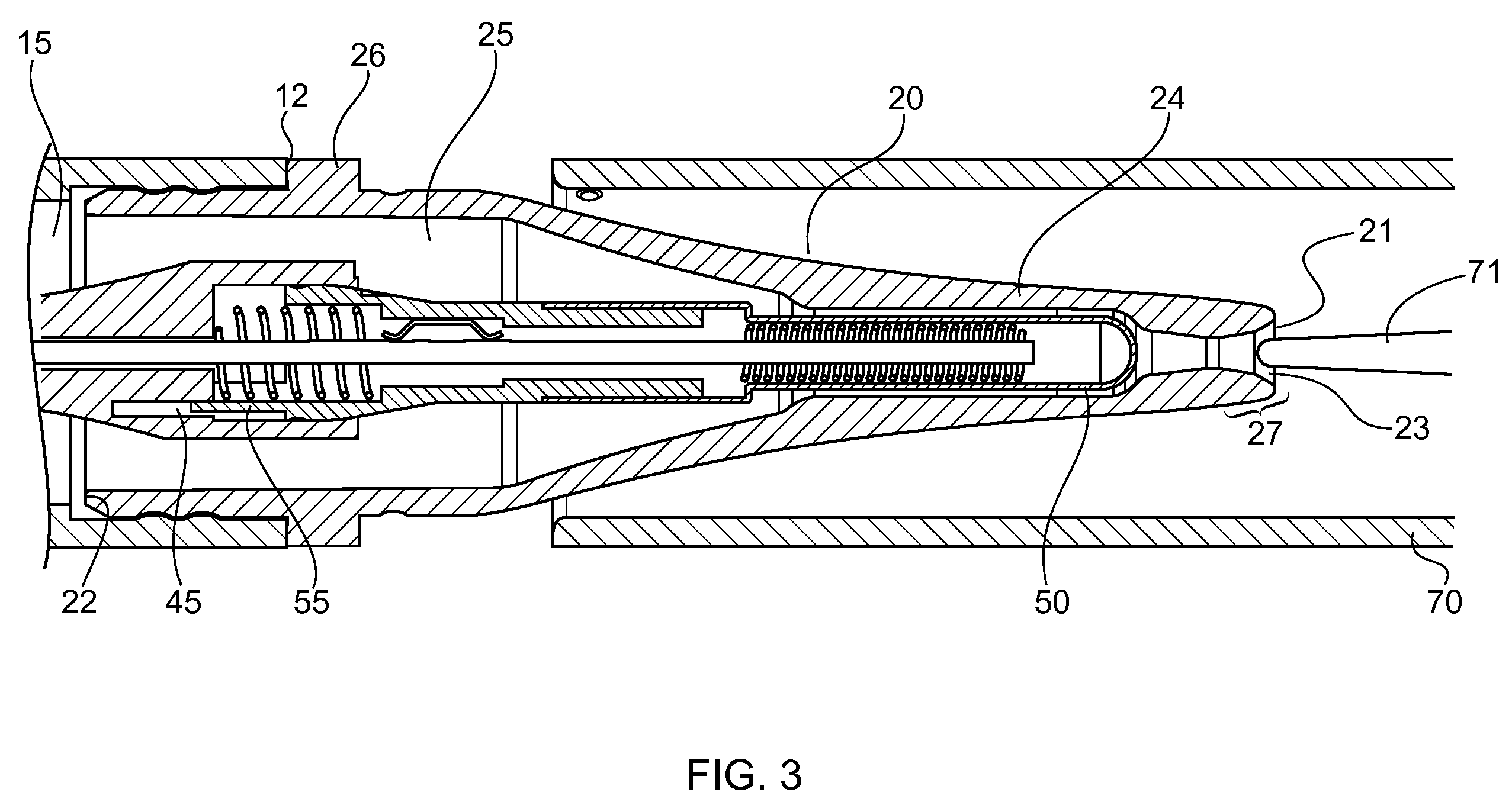However, these two types of applicators have different strengths and weaknesses, different design and use issues, and different problems associated with incorporating heating means into their respective interiors.
The disadvantages of this include subjecting all of the product in the reservoir, or at least more than will be used, to repeated temperature cycles, possibly damaging the product.
Also, heat is lost in the time it takes to transfer the product from the reservoir to the
target surface.
Also, it will generally take longer to raise the temperature of the product to application temperature because more is being heated.
The disadvantages of this include the need to house the electronic circuitry and heating means solely within the applicator.
This is a serious problem in
cosmetics and
personal care applicators which tend to be sleek and designed for easy storage in a small purse or pocket.
Therefore, when the addition of heating components to an applicator requires making the applicator larger, this is a clear
disadvantage.
The
disadvantage of the
plunger is that it is difficult to control the amount of product dispensed and the rate at which it is dispensed.
Therefore, product heating may be uneven from
dose to
dose.
Also, the
plunger takes up space inside the reservoir.
Furthermore, the '685 device is unsuitable for products that flow, either at ambient temperatures or after being heated.
Also, the sliding
plunger mechanism is not an efficient means of dosing a flowable liquid because the amount dosed would be difficult to control.
Clearly, the '685 device should not be used with liquid products that readily flow at ambient temperatures or that flow after being heated.
Disadvantages of the prior art electrical
system include the following: electrical cords tend to deteriorate and be unwieldy; the plug-in
power cord does not offer the mobility and safety of batteries; the
voltage used is much higher than that of batteries; the internal circuitry consists of extended runs of wiring which is difficult and costly to assemble into the housing, compared to a prefab,
printed circuit board; the device has user activated on-off switches, which means that the device may be left on, unintentionally.
The rheostat control is in the form of “a sleeve mounted for rotatable movement around the outer periphery of said
handle for controlling said rheostat.” The need to include a rheostat is a potential
disadvantage of the prior device.
The rheostat design is complex and adds bulky
electronics to the device and their associated costs.
The rheostat creates an unsuitable appearance for a cosmetic applicator.
The rheostat may be moved accidentally during use.
The rheostat adds size, bulk and cost to the device.
A disadvantage of the extended application surface is that the product application is not precise, because product is spread out over the extended surface.
Such a surface is unsuitable for applying product to any relatively small area requiring a confined
dose of product, for example, to the eye area.
Furthermore, the relatively large application surface and the massaging vibration work a product crudely into the skin.
Clearly, the '685 prior art device is not suitable for use as a targeted
personal care applicator and other
massage devices would suffer from similar drawbacks.
Furthermore, the flat application surface is smooth or textureless and relatively hard.
A softer surface would render the '685 device inoperative, or at least less effective, by damping the
massage vibration.
A textured vibrating surface may irritate the skin.
For these reasons, this prior art device should not be provided with a foam or flocked application surface.
Not having a flocked or foamed tip is a drawback of the prior art, because a flocked or foamed tip provides a soft and luxurious product application.
Heating the entire reservoir has the disadvantage of subjecting the entire contents of the container to repeated temperature cycles.
Therefore, this kind of applicator is clearly only suitable for products that are not substantially affected by
temperature cycling, i.e. some waxes.
In contrast, many cosmetic and dermatologic products are unstable when subjected to
temperature cycling.
For products that will be changed structurally or chemically by the application of too much heat or from being too often heated, these prior art devices are wholly unsuitable.
Therefore, prior art devices that heat even a portion of the reservoir, or that heat more product than will be used, are unsuitable for many cosmetic applications.
Another disadvantage of devices that heat the reservoir, or that heat more product than will be used, is the power consumed.
This is costly and inconvenient if batteries need to be replaced often.
Of course, this adds complexity and cost.
Such devices do not offer the convenience and portability of a self-contained cosmetic applicator.
The disadvantage of this is that it is difficult to control the amount of product dispensed and the rate at which it is dispensed.
Therefore, product heating may be uneven from dose to dose.
Also, the
carriage mechanism is again unsuitable for readily flowable liquid products.
Also, the plunger takes up space inside the reservoir.
Disadvantages of the prior art electrical
system include the following: electrical cords tend to deteriorate and be unwieldy; the plug-in
power cord does not offer the mobility and safety of batteries; the
voltage used is much higher than that of batteries; the internal circuitry consists of extended runs of wiring which is relatively difficult and costly to assemble into the housing; it is easy to leave the device on when not in use.
 Login to View More
Login to View More  Login to View More
Login to View More 


